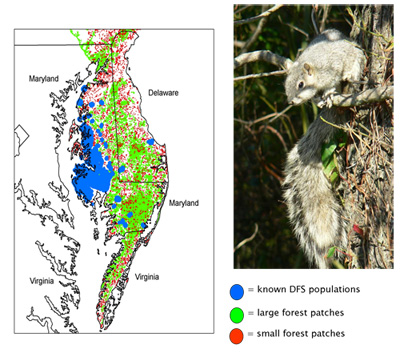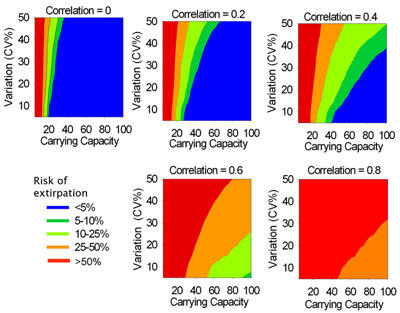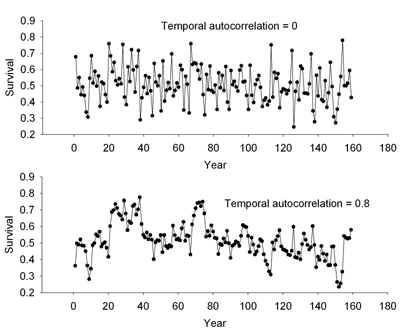
The Delmarva fox squirrel (DFS) is a federally endangered subspecies of fox squirrel that lives on the Delmarva Peninsula of MD, DE, and VA. While a number of reasons led to its listing, habitat loss and population isolation currently limit its potential for long-term persistence – large patches of forest are necessary to house the number of squirrels required to minimize population extinction risks.
Given the restricted distribution of the DFS and the limited amount of large forested tracts, we developed a population model to estimate extinction risk to 100 years for simulated populations of different levels of survival living in woodlots of varying size. Due to many data uncertainties in survival, weather, and predictions of climate change, we developed a process to simulate populations under many different conditions that may occur in the future.

Our results indicate that the maximum population size a forest tract can support (the carrying capacity) is the most important factor in determining the extinction risk to populations. Also quite important is the degree to which year-to-year survival is autocorrelated (i.e., consecutive years of above- or below-average survival). Extinction risk increases with autocorrelation to the point where even the largest forest tracts with the most squirrels have high risks. We used the Palmer Drought Severity Index (PDSI), which is a good measure of vegetation productivity, as a surrogate for food availability and, ultimately survival, for DFS. The PDSI has a lag 1 autocorrelation coefficient of 0.8 (the highest value used in our simulations), we do not expect DFS survival to be nearly so highly related from year to year, but the value indicates that weather patterns from year to year are highly related. Since DFS are affected by productivity of the vegetation, some degree of year to year correlation must exist for DFS.
Comparing our model results with actual populations of DFS on Maryland’s eastern shore indicates that the vast majority of DFS inhabit large forest tracts that currently have low extinction risks. However, several populations are restricted to small woodlots and these do have high extinction risks. Ongoing development near Blackwater National Wildlife Refuge may impact a few of the currently low risk populations as well.

An example of how increasing temporal autocorrelation can influence extinction risk in animal populations is shown at right. As you can see, as the autocorrelation increases, the number of consecutive years of poor survival (or good) increases. Multiple back-to-back years of poor survival make it very difficult for all but the largest populations to avoid extinction. Fortunately, animal populations are not so highly autocorrelated as depicted above. However, we know that weather is autocorrelated and predictions of future climate indicate that the variability will increase. Should this actually happen, many populations may be at increased extinction risk.
Our modeling results are being used by the US Fish and Wildlife Service to guide management and recovery of the DFS. Our model predictions are also being used to determine if and where population reintroductions may be feasible and how many squirrels need to be initially released to maximize the chances of success.
Project PI's:
This research was funded by the National Fish and Wildlife Foundation and the US Fish and Wildlife Service.

